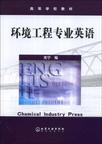环境工程专业英语
2004-10
化学工业出版社
羌宁 编
264
无
《环境工程专业英语》是为提高高等学校环境专业学生的专业文献阅读能力和应用水平而编写的。课文题材广泛,选材上注意专业领域的覆盖面与知识的新颖性,除可满足课堂教学所需外,兼有提供课外阅读材料的功能。 全书共25章,包括环境与可持续发展,生态系统基础知识,环境工程师的职能,空气污染及控制,城市固体废物的全过程管理,有毒有害化学废物的处理处置,噪声及其控制,环境影响评价,国外的环境立法,给水工程和废水管道收集,废水的处理、处置和回用以及废水污泥的处理、处置等,还涉及废水处理工程的设计、运行管理和项目实施等方面,并简要系统地介绍了当今环境保护方面的新思维和科技成就。 为读者能较快扩展专业词汇,在课文中对一些专业词汇和术语用下划线提示,书后附有课文中出现过的词汇和专业术语总表并标注了第一次在书中出现的章号,以便于读者查阅;同时还对课文中的一些较难的句子和段落予以注释,以便于读者理解。 本书力图为读者在环境工程英语阅读能力的提高方面起到引路的作用,除适用环境工程大学三年级以上学生的专业英语学习外,还适用于研究生和有关专业技术人员作为英文环境工程导论阅读材料使用。 限于编者的水平,教材中可能会出现错漏,望读者指正。
《环境工程专业英语》旨在提高环境专业学生的专业文献阅读和应用水平,书中介绍了环境工程领域涉及的水、大气的污染与控制,固体废物的全过程管理,有害废物的处理处置,噪声及其控制,环境影响评价,环境立法,环境与可持续发展等内容,并简要介绍了当今环境保护方面的新科技。编者根据教学中学生易犯的错误在书中有重点地解释说明,具有很强的针对性。书后的单词表注有该词在正文中的首次出处,便于检索。 《环境工程专业英语》适用于高等院校环境工程专业本科生作教材用,也可供环境工程专业研究生及相关专业人员使用。
Chapter 1 Environmental Issue1.1 Environmental Problems1.2 Living Sustainably1.3 Resources1.4 Pollution1.5 Solutions:Working with the EarthNotesChapter 2 Ecosystems2.1 The Concept of Ecosystem2.2 The Structure of Ecosystems2.3 Implications for HumansNotesChapter 3 Cycling of Mineral Nutrients3.1 The Carbon Cycle3.2 The Nitrogen Cycle3.3 The Phosphorus CycleChapter 4 Environmental Engineering and Engineer4.1 The Environmental Engineer4.2 Consultant Services4.3 Studies and Designs4.4 Construction4.5 Start—UP and TrainingNotesChapter 5 Air Pollution5.1 Definition of Air Pollution5.2 Sources of Air Pollutants5.3 General Effects of Air Pollution5.4 General Description of the Air Pollutants5.5 Major Air PollutantsNotesChapter 6 Air Pollution ControlmParticulate Controls6.1 Particulate Collection Mechanisms6.2 Particulate Control EquipmentNotesChapter 7 Air Pollution ControlmGaseous Pollutants Controls7.1 Absorption7.2 Adsorption7.3 Condensatlon7.4 Flaring7.5 Incineration7.6 Emerging TechniquesNotesChapter 8 Integrated Solid Waste Management8.1 The Concept of Solid Waste Management8.2 Functional Elements of a Waste Management System8.3 Integrated Solid Waste Management8.4 Operation of Solid Waste Management Systems8.5 Future Challenges and OpportunitiesNotesChapter 9 The Unit Operations and Processes Used for the Separation and Processing of Waste Materials9.1 Unit Operations9.2 Waste Transformation Through Combustion9.3 Waste Transformation Through Aerobic Composting9.4 Disposal of Solid Wastes and Residual MatterNotesChapter 10 Hazardous Chemical Waste Management10.1 Definition of Hazardous Waste10.2 Chemicals,Lifestyles,and the Environment10.3 Uncontrolled Sites10.4 Responsible Management10.5 Land Disposal Methods10.6 Alternatives to Land Disposal of Hazardous Waste10.7 Site RemediationNotesChapter II Introduction to Environmental Impact Assessment11.1 Terminology1 1.2 1 9 7 3 CEQ Guidelines for the Content of Environmental Impact Statements11.3 Expanded Scope of EIA11.4 Narrowed Scope of EIA11.5 SummaryNotesChapter 12 Environmental Impact Assessment12.1 Planning and Management of Impact Studies12.2 Simple Methods for Identification(Matrices,Networks,and Checklists)12.3 Description of Environmental Setting(Affected Environment)12.4 Indices and Indicators for Describing the Affected Environment12.5 Prediction and Assessment of Impacts on the Environmental Media12.6 Public Participation in Environmental Decision Making12.7 Environmental MonitoringNotesChapter 13 Noise and Noise Control13.1 Noise13.2 Noise ControlChapter 14 Environmental Law and Standards14.1 Environmental Legislation14.2 Features of the National Environmental Policy Act14.3 Federal Legislation and Regulations for Air and Surface Water14.4 International Environmental Law and DiplomacyChapter 15 Environmental Chemical Analysis15.1 The Role and Importance of Environmental Chemical Analysis15.2 Classical Methods15.3 Spectrophotometric Methods15.4 Electrochemical Methods of Analysis15.5 Gas Chromatography15.6 Mass SpectrometryChapter 16 WaterWater Cycle and Sustainable Management16.1 Water16.2 The Water Cycle16.3 Human Impacts on the Water Cycle16.4 Sustainability and Water ManagementChapter 17 Water Supply17.1 Groundwater Supplies17.2 Surface Water Supplies17.3 Water Transmission17.4 Pumps and Pumping17.5 Pump Characteristics Curves17.6 System Head Curves17.7 Operating Head and DischargeNotesChapter 18 Wastewater Collection Systems18.1 Storm Sewer System18.2 Sanitary Sewer System(1)18.3 Sanitary Sewer System(2)18.4 Sewer Pipes and Jointing18.5 Lift Stations in Wastewater CollectionNotesChapter 19 Waste Water Engineering19.1 Wastewater Treatment19.2 Wastewater Reclamation and Reuse19.3 Biosolids and Residuals ManagementNotesChapter 20 Wastewater Treatment Objectives,Methodsand Implementation Consideration20.1 Wastewater Treatment Objectives and Regulations20.2 Classification of Wastewater Treatment Methods20.3 Application of Treatment Methods20.4 Implementation of Wastewater Management ProgramsNotesChapter 21 Introduction to Wastewater Treatment Plant Design21.1 Impact of Flowrate and Mass—Loading Factors on Design21.2 Evaluation and Selection of Design Flowrates21.3 Evaluation and Selection of Design Mass Loadings21.4 Process Selection21.5 Elements of Conceptual Process DesignNotesChepter 22 Wastewater Treatment22.1 Physical Unit Operations22.2 Chemical Unit Processes22.3 Biological Unit ProcessesNotesChapter 23 Biological Nutrient Removal23.1 Nutrient Control Strategies23.2 Nutrient Removal ProcessesChapter 24 Advanced Wastewater Treatment24.1 Need for Advanced Wastewater Treatment24.2 Treatment Technologies Used for Advanced Wastewater Treatment24.3 Removal of Residual Suspended Solids bv Granular—Medium Filtration24.4 Removal of Residual Suspended Solids by Microscreening24.5 Removal of Toxic Compounds and Refractory Organics24.6 Removal of Dissolved Inorganic SubstancesChapter 25 Sludge Treatment and Disposal25.1 Sludge Treatment Flow Diagrams25.2 Preliminary Operations25.3 Thickening(C0ncentration)25.4 Stabilization25.5 Anaerobic Sludge Digestion25.6 Aerobic Sludge Digestion25.7 Composting25.8 Conditioning25.9 Disinfection25.10 Dewatering25.11 Heat Drying25.12 Thermal Reduction25.13 Land Application of Sludge25.14 Other Beneficial Uses of Sludge25.15 Final Sludge and Solids Conveyance,Storage,and DisposalGlossary主要参考文献

无